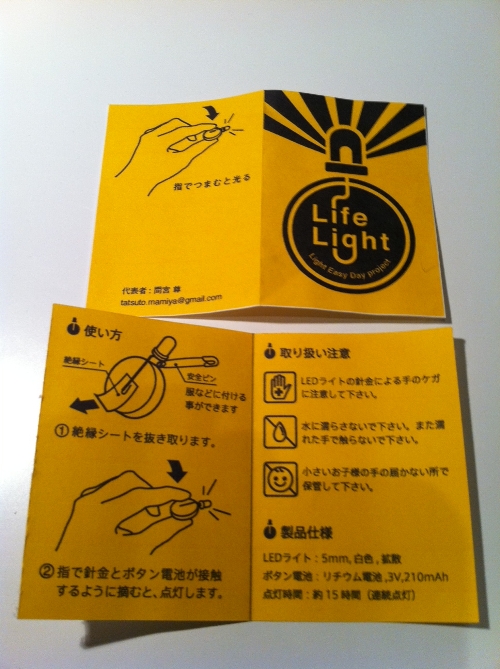Art & Design
What art majors can do for people living in areas afflicted by the Great Eastern Japan Earthquake
2011.03.25 Mitsuko Iwai
"Life Light" that was born from a Tama Art University student's desire to deliver light of hope to people in Tohoku.
Aftershocks still continue, so people living in areas afflicted by the Great Tohoku Earthquake may still be told to evacuate immediately, at any given time. I wish there was a way to deliver a portable light to each and every person living in such conditions.
What Mr. Tatsuto Mamiya, a student at Tama Art University created in response to his wish is a very simple button light using an LED and 2 button batteries. You can use a safety pin to attach the light to your chest. It is also pocket size, so you can also keep it in your pocket and take it out when you need it. The light will last for about 15 hours, and it is bright enough to light your immediate vicinity in pitch darkness. Hearing that there are not enough flashlights in the afflicted area, he shared his idea about mass producing this mini light and delivering it to the people in the Tohoku region on twitter and mixi (a Japanese SNS).
There were many people who supported this idea, but there was also quite a lot of skepticism - "Is it really necessary?" "Isn't there another way to help?" We can only imagine what the needs of the people in the afflicted area are, and because he didn't have a local network , the project did not move forward. The idea had hit a wall.
Then, companies contacted him and told him they wanted to help; they provided 800 LEDs and 2,000 button batteries free of charge . Mr. Mamiya got together with his friends and started making the button lights. Professor Tatsuya Wada from the Department of Product and Textile Design, Tama Art University also joined the project. Together they took a closer look at usability and safety and Professor Wada named the product, "Life Light." A wonderful package design was developed as well.

By March 24th, Mr. Maimiya and his team had created 750 "Life Lights." They were thinking of selling them in Tokyo and donating the proceeds to charity, but NPOs they knew contacted them saying they wanted to help deliver them. So on the 25th, 600 were sent to Kesennuma, etc. Currently the team is creating an additional 1,000 units.
Can an individual's idea help move schools and companies into action? Although there may have been hesitation when he first started the project, Mr. Mamiya explains, "with products that are on the market there is a limit to the available quantity, but with this light, we can make as many as we need as long as we have the manpower and materials." Ideas unique to students majoring in art have given way to a product design developed for the disaster that has moved many people into action, and their desire to help is being delivered to people living in afflicted areas.
Related URL/media
http://lighteasyday.tumblr.com/
![]()









